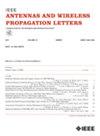A Low-Profile Shared-Aperture Patch Antenna With 2-D Scanning Capability
IF 4.8
2区 计算机科学
Q2 ENGINEERING, ELECTRICAL & ELECTRONIC
引用次数: 0
Abstract
This letter presents a novel low-profile patch antenna with shared aperture and two-dimensional scanning capability. Compared with the state-of-the-art designs, the proposed antenna offers low cost and easy integration due to its simple structure. The millimeter-wave (MMW) stacked patch antenna array is embedded in the weak electric-field (具有二维扫描能力的低轮廓共享孔径贴片天线
本文提出了一种具有共享孔径和二维扫描能力的新型低轮廓贴片天线。与目前最先进的设计相比,该天线结构简单,成本低,易于集成。将毫米波(MMW)堆叠贴片天线阵列嵌入到微波(MW)双贴片天线的反相TM20模式和TM12模式的弱电场(E-field)区域。这种设计在相同的孔径内交织两种天线类型,实现自然隔离。MW补丁上的槽位可以修改反相TM20模式和TM12模式的电流路径,实现低姿态的双模工作。堆叠的贴片在毫米波频段提供宽带操作。此外,毫米波贴片上的周期性缝隙有助于毫米波波束扫描,在E面和h面实现±45°波束扫描。为了验证所提出的毫米波和毫米波共享孔径贴片天线的原型,该天线的总尺寸为0.38λL × 0.48λL × 0.022λL (λL为自由空间4.6 GHz工作波长)。测量结果表明,10db阻抗匹配带宽分别为6.6%和27.1%,峰值增益分别为7.2 dBi和15.5 dBi。
本文章由计算机程序翻译,如有差异,请以英文原文为准。
求助全文
约1分钟内获得全文
求助全文
来源期刊
CiteScore
8.00
自引率
9.50%
发文量
529
审稿时长
1.0 months
期刊介绍:
IEEE Antennas and Wireless Propagation Letters (AWP Letters) is devoted to the rapid electronic publication of short manuscripts in the technical areas of Antennas and Wireless Propagation. These are areas of competence for the IEEE Antennas and Propagation Society (AP-S). AWPL aims to be one of the "fastest" journals among IEEE publications. This means that for papers that are eventually accepted, it is intended that an author may expect his or her paper to appear in IEEE Xplore, on average, around two months after submission.

 求助内容:
求助内容: 应助结果提醒方式:
应助结果提醒方式:


